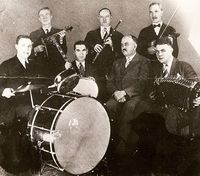Annotation:My Darling Asleep: Difference between revisions
No edit summary |
No edit summary |
||
| Line 1: | Line 1: | ||
{{TuneAnnotation | {{TuneAnnotation | ||
|f_tune_annotation_title=My_Darling_Asleep | |f_tune_annotation_title=My_Darling_Asleep | ||
|f_annotation=[[File:shamrock.jpg| | |f_annotation=[[File:shamrock.jpg|200px|thumb|left|Dan Sullivan's Shamrock Band]] | ||
'''MY DARLING ASLEEP''' (Mo Muirnin 'Sa Codlad). Irish, Double Jig. D Major. Standard tuning (fiddle). AABB (most versions): AABBCC (Harker/Rafferty). A popular Irish session tune; so much so, in fact, that it is sometimes seen as hackneyed, leading some wags to call it "My Darling's a Sheep." An uncorroborated story has Harry Bradshaw maintaining that Chief Francis O'Neill originally collected the tune from Abram Beamish as "My Darling in Bed," but amended the title when he included it in MOI so as to preclude any suggestive connotations. Williamson's source, Leo Rowsome, died in 1970 after establishing himself as a key figure in Irish piping, both as a player and maker of pipes. Rowsome recorded the jig in 1948, but the first sound recording of "My Darling's Asleep" was by Dan Sullivan's Shamrock Band, in 1929. | '''MY DARLING ASLEEP''' (Mo Muirnin 'Sa Codlad). Irish, Double Jig. D Major. Standard tuning (fiddle). AABB (most versions): AABBCC (Harker/Rafferty). A popular Irish session tune; so much so, in fact, that it is sometimes seen as hackneyed, leading some wags to call it "My Darling's a Sheep." An uncorroborated story has Harry Bradshaw maintaining that Chief Francis O'Neill originally collected the tune from Abram Beamish as "My Darling in Bed," but amended the title when he included it in MOI so as to preclude any suggestive connotations. Williamson's source, Leo Rowsome, died in 1970 after establishing himself as a key figure in Irish piping, both as a player and maker of pipes. Rowsome recorded the jig in 1948, but the first sound recording of "My Darling's Asleep" was by Dan Sullivan's Shamrock Band, in 1929. | ||
Revision as of 16:35, 25 April 2020
X:1 T:My Darling Asleep M:6/8 L:1/8 R:Jig B:Jerry O'Brien's Accordion Instructor (Boston, 1949) Z:AK/Fiddler's Companion K:D d/e/|"D"fdd "A7"cAA|"G"BGG "A7"A2G|"D"FAA "Bm"def|"Em"gfg "A7"eag| "D"fdd "A7"cAA|"G"BGG "A7"A2G|"D"FAA def|"A7"gec "D"d2:| |:A/G/|"D"FAA ABB|FAA "G"BGG|"D"FAA "Bm"def|"Em"gfg "A7"eag| "D"fdd "A7"cAA|"G"BGG "A7"A2G|"D"FAA def|"A7"gec "D"d2:|

MY DARLING ASLEEP (Mo Muirnin 'Sa Codlad). Irish, Double Jig. D Major. Standard tuning (fiddle). AABB (most versions): AABBCC (Harker/Rafferty). A popular Irish session tune; so much so, in fact, that it is sometimes seen as hackneyed, leading some wags to call it "My Darling's a Sheep." An uncorroborated story has Harry Bradshaw maintaining that Chief Francis O'Neill originally collected the tune from Abram Beamish as "My Darling in Bed," but amended the title when he included it in MOI so as to preclude any suggestive connotations. Williamson's source, Leo Rowsome, died in 1970 after establishing himself as a key figure in Irish piping, both as a player and maker of pipes. Rowsome recorded the jig in 1948, but the first sound recording of "My Darling's Asleep" was by Dan Sullivan's Shamrock Band, in 1929. Sullivan's band recorded some 106 sides in the 78 RPM era, a prolific output. Personnel included Sullivan on piano, Murty Rabbett on piccolo, Neil Nolan on banjo, and George Tapley on accordion. Some see similarities in "Wink of Her Eye (2)," "Bold John O'Leary."

